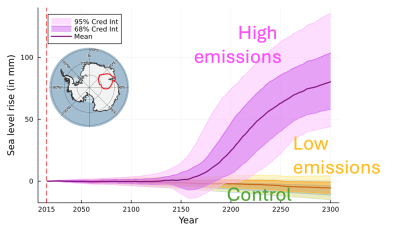Probabilistic Projections of Sea-Level Contribution from a Stable Antarctic Ice Sheet Sector
The sector of the Antarctic Ice Sheet flowing into the Amery Ice Shelf has remained remarkably stable over the period of historical observations, suggesting it is unlikely to make a significant contribution to future sea-level rise. Using large ensembles of ice-sheet model simulations and statistical calibration techniques, we quantified uncertainty in the future sea-level contribution from this region, finding that while under low greenhouse gas emissions scenarios, the future contribution is negligible, ocean-driven melting under a high emissions scenario is likely to increase future sea level from this region by 46 to 133 mm at 2300.
Our results show that while more stable than other regions of Antarctica, the Amery Ice Shelf sector is susceptible to ocean-driven melting, and this result is robust, accounting for uncertainty in key ice-sheet model parameters. This study demonstrates an efficient Bayesian calibration and uncertainty propagation workflow for ice-sheet model projections that can be extended to the entire ice sheet.
The Amery Ice Shelf drains 16% of the East Antarctic Ice Sheet and has been long considered stable to climate change due to its location in a narrow embayment and surrounded by cold ocean water. However, recent global climate model projections through 2300 indicate that extreme ocean warming in the region and subsequent ocean-melt-driven removal of the ice shelf is possible after 2100, casting the future stability of this region into doubt. At the same time, ice-sheet model projections are subject to uncertainty from poorly known model parameters, highlighting the need for uncertainty quantification. To address this, we applied a regional configuration of the E3SM ice-sheet component, MALI, to generate an ensemble of 200 simulations with parameter values perturbed over their likely ranges. Using statistical emulation of the resulting ensemble, we performed Bayesian calibration on the uncertain model parameters, using observations of key glacier quantities from the historical period. By sampling from the posterior distribution of parameter values and utilizing statistical emulation of the model ensemble, we generated calibrated, probabilistic projections under two climate scenarios. Accounting for the uncertainty in ice-sheet model parameters, we find that the difference between the two projections becomes statistically significant around 2130 and, under the high greenhouse gas emissions scenario, the Amery sector would contribute 46 to 133 mm to the global sea level.

